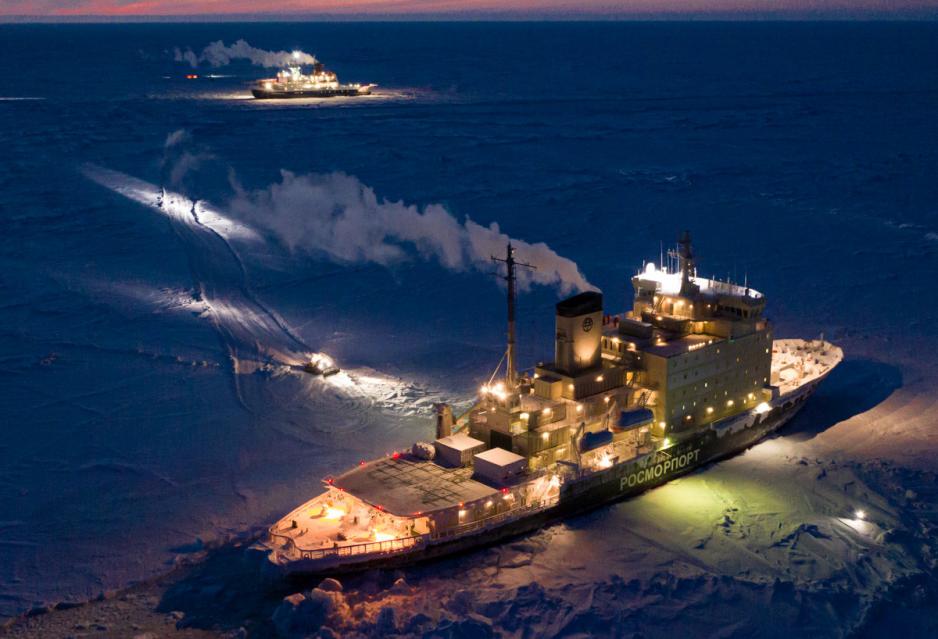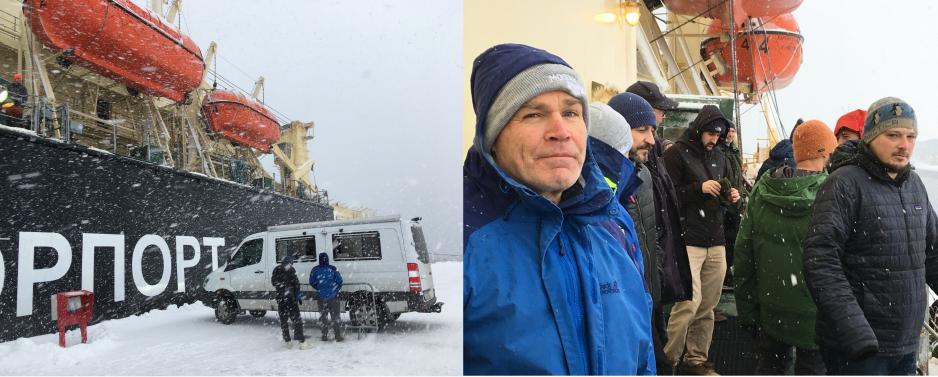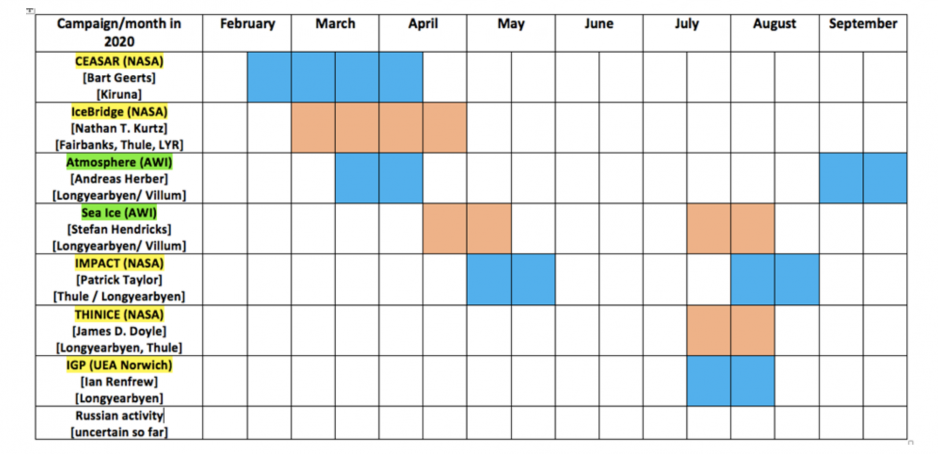Social Distancing at the North Pole: How the Corona Pandemic Affects Ice-bound Arctic Scientists

Russian icebreaker Kapitan Dranitsy with Polarstern in the background (Source: Courtesy of AWI/Steffen Graupner)
The impacts of Covid-19 are now felt at the North Pole. Planned aerial surveys and resupply flights have been cancelled to protect scientists aboard the Polarstern icebreaker near the North Pole.
When the Polarstern set out for its year-long expedition in September 2019 to drift across the central Arctic Ocean enclosed by ice the primary challenge may have revolved around harsh weather or ice conditions possibly delaying resupply missions and crew exchanges. Six months later, the global Corona crisis has reached the international MOSAiC expedition.
A series of scheduled flights to exchange its crew and researchers of 100 people in mid-April have now been cancelled according to the expedition leader, Markus Rex, an atmospheric scientist at the Alfred Wegener Institute Helmholtz Centre for Polar and Marine Research.
“There’s no way to carry out these flights for the crew rotation. That has a major impact on how we plan the expedition,” explains Rex.
Indicative of how quickly things are changing due to the Corona pandemic, even at the North Pole, just two weeks ago the expedition leadership was still hopeful that the flights could happen. “The planned crew exchange by aeroplane in early April should – barring unforeseen developments – still be possible,” said officials of the Alfred Wegener Institute in mid-March.
Of course the expedition has planned for the eventuality of cancelled resupply missions and the Polarstern carries enough supplies to last until June. Nonetheless, the expedition’s management is now looking for alternative ways to carry out the next crew exchange originally scheduled for April, including utilizing another icebreaker or moving up a planned resupply mission in June of the Swedish icebreaker Odin.
A lengthy return to Tromsø
The one-year MOSAiC expedition relies on six teams of crew and researchers who travel to and from the Polarstern via icebreaker or airplane. The first exchange occurred towards the end of 2019. The second swap of staff happened in early March. The relieved crew and researchers left the Polarstern and departed for the return journey to Tromsø onboard the Kapitan Dranitsyn on March 6th.
Yesterday these crew and researchers returned to Tromsø after a three week voyage. In addition to delays from strong ice ridges and adverse weather conditions on its way back to Northern Norway – requiring a refueling rendezvous with the icebreaker Admiral Makarov – the expedition also faced uncertainty regarding the Coronavirus.

Members of the second leg of the MOSAiC Expedition returning to Tromsø aboard the Kapitan Dranitsyn. (Source: Courtesy of AWI/Folke Mehrtens)
Would the crew and researchers be allowed to enter Norway given the current travel and entry restrictions? Fortunately, Norwegian officials granted an exemption and permitted a charter flight to depart for Bremen, Germany from where researchers will travel onwards to their home countries.
No aerial survey flights
Earlier this month a series of planned aerial survey flights taking off from the archipelago of Svalbard were cancelled. Following Norway’s comprehensive measures to combat the spread of Covid-19 the project’s management decided to suspend an aerial component of the mission for the time being. The decision also came on the heels of one of the participating researchers for the aerial surveys testing positive for the virus and remaining in quarantine in Germany.

Schedule for aerial survey campaigns associated with the MOSAiC Expedition. (Source: Courtesy of AWI)
“The highly unusual situation at the moment leaves us no choice. We’d like to thank everyone who was involved in the months of preparation, and who did everything within their power, up to the last minute, to make the flight campaigns a reality,” says Dr Andreas Herber from the Alfred Wegener Institute, Helmholtz Centre for Polar and Marine Research (AWI), and coordinator of the MOSAiC airborne campaigns.
Additional aerial campaigns are planned for the summer months. No decision has been made as to their status.
Six crews and resupplies during one year
Due to the Coronavirus the three flights via Russian Antonov planes in the middle of April now had to be scrapped. The original MOSAiC Implementation Plan states that the flights would depart from Cape Baranov, Russia and that “the aircrafts will operate in twin flights. To exchange all 90 passengers at Polarstern, three twin flights are necessary. No resupply is planned at this time.”

Resupply and crew exchange schedule for the MOSAiC Expedition. (Source: Courtesy of AWI)
In the absence of these flights MOSAiC is considering chartering another icebreaker or moving Odin’s resupply mission up to mid-May from mid-June. Later in the year China’s Xue Long is scheduled to rendezvous with the Polarstern. Keeping the crew and staff aboard the ship safe from the virus is the highest priority.
“We’ve rapidly responded to the pandemic with a comprehensive safety concept and strict medical-diagnostic profile, in order to reduce the risks for all expedition participants to a minimum. The spreading wave of infections poses an immense challenge for this international expedition,” explains Rex. As a result of this, future crew exchanges will likely incorporate a 14-day quarantine for anyone heading to the Polarstern.
A single case aboard the icebreaker would likely prove detrimental to the expedition. While the ship is equipped with a quarantine ward, recent examples from cruise ships around the world exemplify how quickly the virus can spread when social distancing and home quarantines are not an option. And the spread of Covid-19 aboard ships is not limited to tourism or science voyages; the U.S. Navy nuclear aircraft carrier Theodore Roosevelt is anchored off the U.S. territory of Guam with 5,000 sailors, of which more than a hundred have tested positive. The ship’s captain issued an urgent plea for help allowing sailors off the ship.

